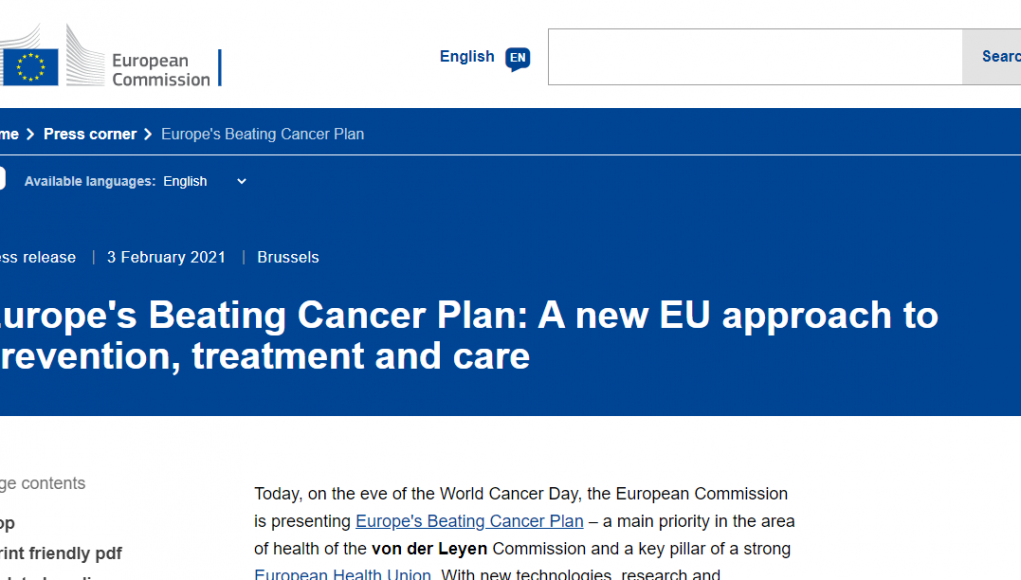“Europe’s Beating Cancer Plan” (EBCP), aims to create a ‘tobacco-free generation’ by 2040. It is based on four key pillars: prevention, early diagnosis, treatment, and follow-up care – with seven flagship initiatives and a number of supporting actions.
The official draft was presented to Europe’s Health Ministers on the 16th of March, allowing for an exchange of views on the plan. Meanwhile, the document has raised alarm amongst Europe’s tobacco harm reduction and vaping groups.
“Europe’s Beating Cancer Plan is a historic chance to beat cancer and the Commission is about to botch it. Vaping is not the same as smoking and treating the two as the same is a mistake that could prevent thousands of smokers from quitting. What we have seen in the leaked plan is very concerning and I hope that the version announced will correct this flawed approach,” said World Vapers Association (WVA) Director, Michael Landl.
Reducing cancer by moving high-risk combustible tobacco users to low-risk products
Former Director of Action on Smoking and Health in the UK, and renowned tobacco harm reduction advocate Clive Bates, concurs. In a recent interview on Snusforumet Bates discussed what the EU cancer plan got right – and what it didn’t. He started off by highlighting the opportunity to reduce cancer by moving those who use nicotine from high-risk combustible tobacco, to low-risk non-combustible products, such as snus, vapes and nicotine pouches.
“The evidence will never be perfect, but what we do know is that the exclusive use of smoke-free products presents risks that are one to two orders of magnitude lower than smoking. Instead of working out how we could exploit that huge difference in risk for public health benefit, Europe’s Beating Cancer Plan appears to make it more difficult and less appealing for smokers to switch.”
He explained that failing to recognize this difference in risk, and condemning safer options will just keep smokers hooked on the more harmful products. “Europe’s Beating Cancer Plan makes a fundamental error in setting an overall goal to reduce tobacco use to below 5 percent by 2040. It should focus on smoking. The key difference in risk is between combustible and non-combustible products, not between tobacco and non-tobacco. By focusing on tobacco use, not smoking, the Commission implicitly rejects the value of switching from high-risk tobacco products like cigarettes to low-risk tobacco products like snus. This is a grave error, but I doubt it was an accident.”
Bates said that EU lawmakers seem more concerned with eliminating nicotine use than cancer. “It’s hard to know what motivates them. Though they say their goal is reducing cancer, they act as though it is more to do with eliminating nicotine. I believe they will never succeed in achieving a ‘nicotine-free society’ because it is a popular drug without harmful side effects and not very dangerous when consumed in smoke-free products.”
Sweden’s success with snus
When asked about the “Swedish Experience” of achieving a smokefree status with the help of snus, Bates explained why he finds it both inspiring and depressing. “It is inspiring because there is clear evidence that snus displaces smoking and can displace it almost completely. Adult smoking prevalence in Sweden is already close to 5 percent and the levels of cancer and heart disease among men, until recently the main users of snus, are by far the lowest in the European Union.”
“The depressing part is that the European Union continues to ban snus in every member state except Sweden. It illustrates just how irrational policymaking can be in the EU institutions, staffed by unaccountable elites, and surrounded by the interest groups that populate the Brussels ‘hive’,” he added.
The expert emphasized that it is of utmost importance that nicotine users speak up. “We need to connect with the people who connect with citizens. That means the Members of the European Parliament and to some extent the members of the Council working groups that address these issues. In 2013, the Commission wanted to regulate vaping products as though they were medicines. That approach would have killed off the category and led to many more smoking instead of vaping. Fortunately, many elected representatives who deal with real EU citizens saw this would hurt the people they serve and secured a life-saving compromise.”
“Dealing with EU policy is always very difficult for ordinary citizens, so I recommend joining a consumer advocacy group. They will represent your interests, but more importantly, they will advise you on when and how to have a personal impact.”
https://www.vapingpost.com/wp-admin/post.php?post=42811&action=edit&lang=en








